Sony Ericsson Xperia X10a review
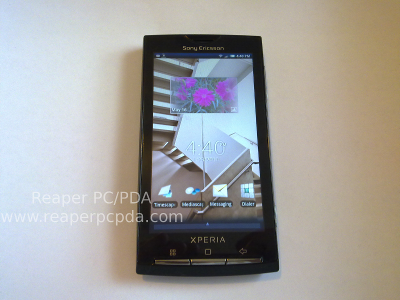
The Xperia X10a is Sony Ericsson's first foray into the crowded Android smartphone universe. So how does their intro unit stand up to competition? Read on to find out.
(All images in this review can be clicked on for a larger view. These images are large so they may take awhile to load depending on your Internet connection speed)
As a phone:
In this day and age it is easy to forget that the intended purpose of these devices is to make phone calls. So how does the X10a stack up in this regard? Pretty well. The volume is clear and not once did anyone I call on the device complain about sound quality. Overall the sound quality for voice communication was excellent as is typical with Sony Ericsson devices. With a headset the device was just as clear. The device performs as one would expect from a proper phone. It tends to get great cellular reception on both 2G and 3G networks (In the case of the X10a that is AT&T's 3G network).
As a camera:
As typical with high-end Sony Ericsson handsets, this unit has a camera that can compete with point and shoots for casual use. Pictures come out crisp and clear on the 8.1 mega pixel shooter on the back. The problem there is that there is no camera lens cover. So be sure to keep the lens clean before taking a pic. Also, the unit does not hold up too well in low light situations. There is a single small LED flash to try and help with this feature, but it does not give off enough light to pull off a decent shot.
Same goes for video. Excellent quality in day light along with a steady frame rate. After the planned 2.1 update, it is said that the device will achieve 720p video playback ability. Currently this update is slated to be released within the fourth quarter of this year.
Sharing all of the high quality (in good lighting conditions that is) captured pictures and videos can easily be done via facebook, picasa, flickr and other online methods.
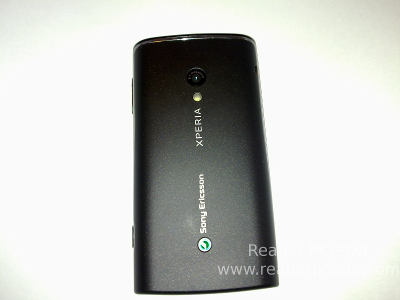
Above is a picture of the back of the X10a with the camera sitting above the Xperia name print on the back.
Click here to see a gallery of pictures taken with the Xperia X10a.
As a media player:
Thankfully Sony Ericsson applied some of their own portable media player touches to this device. Using the custom "Media Scape" interface was far better than on any stock Android OS device to date.
The entire experience of handling media consumption on the devices is very reminiscent of the Walkman branded units that were once prevalent in the Sony Ericsson lineup. Once in Media Scape mode, the presentation of media becomes the focus of the unit's user interface.
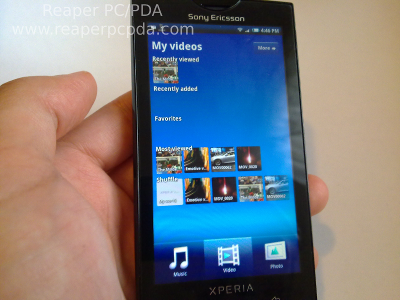
Above is a picture of the media scape interface in video mode.
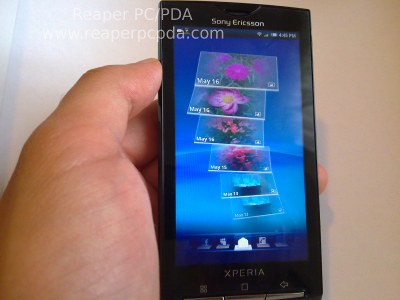
Above is a picture of the time scape (similar to media scape, but is used for itmes that can be shown in chronological order such as pictures, texts, and facebook messages). interface in picture mode. Notice that the pictures on the device are stacked like a deck of cards floating in space. To browser through them you just slide forward or backward through the pictures. Then, to view a picture full screen you just select it with a touch of your finger.
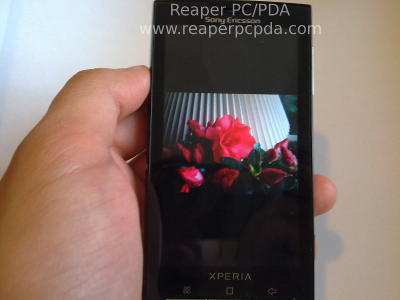
Here is an example of what you would get once a picture is selected.
Below is an example of an image displayed in a widget on the home screen.
Clicking on the widget brings up the timescape interface in picture mode.
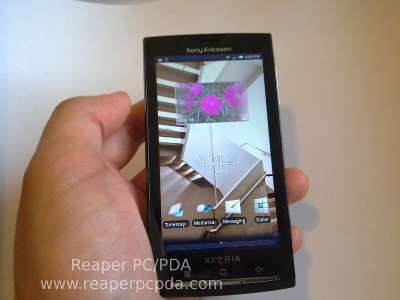
As a PDA (Personal Digital Assistant):
This device gives you two options. You can use the Android standard applications and live the Google lifestyle, or you can use the Moxer third party applications. The Moxer apps replace each aspect of the phone that could normally be handled by a default Google Android application. This includes: mail, contacts, etc. Also Sony Ericsson has included other applications to fill in where Moxer does not have an alternative. This includes: Waypoint Navigator, Sony PlayNow(application store/ media store). This way a user could make use of the device without integrating into Google services if they so choose.
As a messaging device:
Despite the fact that the unit has a capacitive touchscreen, it does not support multitouch. This limits the speed of typing with the unit's current firmware. However, as previously mentioned, Sony Ericsson promises to bring Android 2.1 to the device before the end of the year. This will give the unit multitouch capability and should increase the typing speed possible with the virtual keyboard.
Also depending on the size of your hands the device's portrait virtual keyboard could prove to be difficult to use due to the size of the on screen keys. This problem is solved by using the device's keyboard in landscape mode. There are some negatives to landscape use though:
1) this eliminates the ability to use the device one handed.
2) in an instant message conversation the chat window will be covered by the keyboard till you are done typing.
For those already used to touchscreen only devices these issues are already a normality as most all virtual key board systems have the same flaw as far as single handed usability and screen obstruction. For those used to a physical qwerty keypad, these issues could be troublesome.
With the preinstalled software the device does come with Google Chat software for keeping in touch with other Google Chat users. Also you could get many free or pay for third party instant messaging software for other IM protocols.
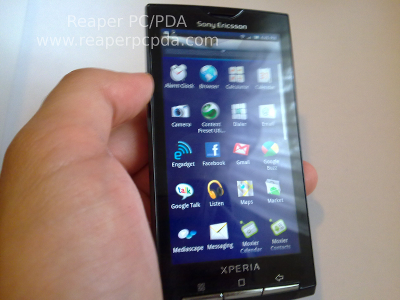
As seen here are the facebook, and Google Talk applications. These come preloaded on the device for keeping in touch on both social and instant messaging networks.
As a browser:
As a mobile web browsing machine, the device does about as good as any other Android device with a webkit browser. The one nice advantage is the 4" screen coupled with the device's 800x480 resolution screen. This makes browsing through web pages much easier due to the larger screen real estate.
Also, the 1Ghz CPU at the X10a's core makes for quick web page rendering.
The downside once again comes back to the unit's Android 1.6 base. It does not have flash support out of the box and will have to wait till Sony Ericsson updates the firmware to a supported version of Android.
As a GPS Navigation unit:
Due to its Android based OS, this phone does have an advantage over its competitors in the fact that it has the most advanced and complete version of Google Maps available for it. This means that the device has free tun by turn navigation in about a dozen countries.
The device also has a third party GPS solution available, but with Google Maps preloaded there is little reason to make use of it.
The one downside to the Google Maps solution is that the device must have a data connection at all times to operate. If you happen to drive outside of cell coverage and it is time for Google Maps to pull the next section of the map(it only stores a certain amount at a time then must retrieve the rest) then you will be greeted with errors.
On the plus side, the device's large 4” screen makes viewing maps as easy as most dedicated GPS units. Also the ability to do public transport and walking directions in supported markets makes this a very capable navigation unit.
Conclusion:
For Sony Ericsson faithful who are looking for an Android unit by their favorite manufacturer, you cannot get much better than this. For Android die-hards, the use of Android 1.6 on initial release might be a bit of a turn off. Also since the unit has a customized interface, the updates will always lag behind the "with Google" units since Sony Ericsson has to customize it before it is released. (Update: Android 2.1 is rolling out to X10s now)
For anyone that does not care about the latest OS, but likes the styling and day light picture capabilities of this device, it is a good option to consider.
Also of note is that a branded version of this device is now available on AT&T. So if you are an AT&T customer, or interested in becoming one, you can get this device at a lower price with a 2 year contract agreement.
Click here for the picture gallery to see more of the device as well as higher resolution pictures.
The unboxing of the device can be viewed by clicking here.
